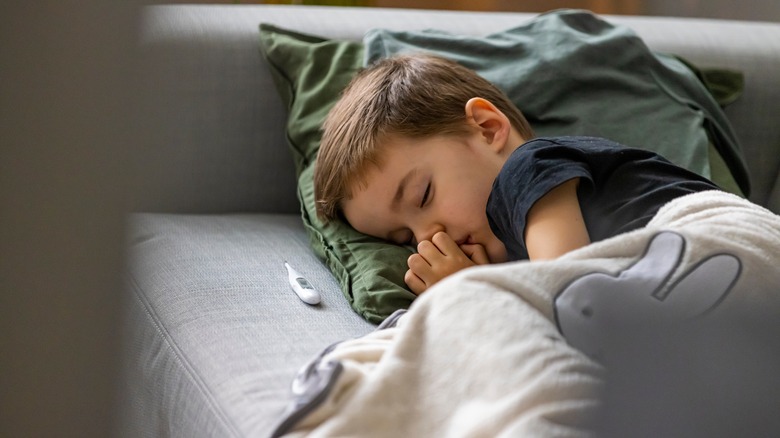When Should You Take Your Child To The ER For A Fever?
The body temperature is regulated by the hypothalamus (via RUSH University Medical Center). According to the university, when the body is fighting an infection, the hypothalamus sends signals to the body to change its temperature.
It's vital to note that fever is a symptom, not a disease, and it's usually the body's natural response to an infection or illness, per Johns Hopkins Medicine. In children, a fever is a body temperature above 99.5 degrees Fahrenheit taken orally or 100.4 degrees Fahrenheit measured rectally, per the Cleveland Clinic. According to the clinic, the normal body temperature is 98.6 degrees Fahrenheit. A slight rise above normal in children is typically a sign the immune system is fighting an infection.
While a fever can make a child feel uncomfortable, it is not usually dangerous, especially if they're still active and playing, says the clinic. In most cases, the fever will go away within a few days, explains the clinic. But sometimes, a fever can signify a more serious condition that warrants medical attention. Here's what to know.
Possible causes of fever in children
Fever in children is a common symptom of many different conditions and can be caused by a variety of factors — the most common cause being an infection, such as a cold or flu, per MSD Manuals. Bacterial infections, such as pneumonia, ear infection, or urinary tract infection, can also cause a fever.
According to MSD Manuals, young children are at higher risk of certain infections, including meningitis and sepsis. Other possible causes of fever in children include heat stroke, cellulitis, Kawasaki disease, and certain types of cancer, such as leukemia. Some children may also develop a fever after receiving certain vaccinations, according to Nemours Kids Health.
It is important to note that in some cases, the cause of a fever in a child may not be immediately apparent and may require further evaluation by a medical professional who can take a thorough medical history and perform a physical examination.
Symptoms that often accompany a fever
Although a fever is a common symptom of many illnesses, the increase in temperature is sometimes accompanied by a feeling of coldness or shivering, says Medical News Today. A fever can also cause various other symptoms, including sweating, fatigue, or exhaustion. It can also cause dehydration, as the body loses fluids through sweating. Some children also experience muscle aches and weakness as the body fights off the infection.
According to Johns Hopkins Medicine, many children also have a runny nose if the fever is caused by viral or bacterial infections, especially those that affect the respiratory system. Lastly, nausea and vomiting can accompany fevers that are caused by viral or bacterial infections, mostly those that affect the gastrointestinal system, like noroviruses, per the Mayo Clinic.
If your child has a fever, it is important to monitor their symptoms and seek medical attention if they seem to be getting worse or if other worrying symptoms develop. In general, it's always better to be safe and consult with a doctor.
When to see a doctor for fever in children
While most fevers in children can be managed at home with simple remedies, there are certain situations in which it's important to seek medical attention. A fever of 104°F or higher, or a fever that lasts longer than five days or doesn't respond to treatment, should be evaluated by a doctor, explains the Cleveland Clinic. Infants under 3 months old with a fever higher than 100.4°F, or children between the age of 3 and 6 months that have a fever higher than 102.2°F, should be seen by a doctor right away, according to the U.K. National Health Service (NHS).
Also, suppose your child's fever is accompanied by concerning symptoms such as difficulty breathing, difficulty waking up, rash, stiff neck, pale skin and lips, rash, or extreme agitation. In that case, immediate medical attention is needed, says the NHS. You should also call 911 if your child has a seizure that lasts longer than 5 minutes; if it lasts less than five minutes, you don't need to call 911 but you should still seek immediate medical attention, advises Cleveland Clinic.
Remember that your child may be more at risk for a serious infection, especially if you've recently traveled to areas where certain infections are prevalent, or if your child has been exposed to someone with a contagious illness. Be sure to monitor your child's symptoms and contact a doctor if you have any concerns.
Some methods to take your child's temperature
Taking a child's temperature is a simple way to determine if they have a fever, which can be a symptom of many illnesses. Several different types of thermometers are available, each with its own advantages and disadvantages.
An oral thermometer can be used for children from the ages of 4 or 5, per Nemours Kids Health. According to the source, the thermometer is placed under the tongue until the correct amount of beeps is heard.
According to Nemours Kids Health, a rectal thermometer is the most accurate way to take an infant's or a young child's temperature. The thermometer should be first washed and then lubricated with a small amount of petroleum jelly before insertion, and should be inserted about half of an inch into the rectum, per the source.
A temporal artery thermometer is a non-invasive method that uses infrared technology to measure the temperature of the temporal artery in the forehead, per WebMD. This method is convenient for children, although it may be less accurate than other methods. When taking a child's temperature, it's important to follow the manufacturer's instructions and to ensure that the thermometer is clean and properly calibrated before use.
Home remedies for managing fever in children
As mentioned, a fever in children is a common symptom of many illnesses — depending on the cause and severity, a fever can be managed at home with some simple remedies. Start by giving your child plenty of fluids to drink. Water, juice, and clear broths are best, per Healthline.
Dress your child in light clothing and keep the room comfortable. If your child is uncomfortable, you can offer your child a fever reducer such as ibuprofen (Advil, Motrin) or acetaminophen (Tylenol). Just be sure to follow the dosage instructions on the package, and consult with your doctor beforehand if your child is younger than 2 years old. Avoid giving aspirin to children below age 18 because of the risk of Reye's syndrome, per Healthline. This serious condition can cause liver and brain damage.
Lastly, encourage your child to rest. In general, keep an eye on your child's symptoms and seek medical assistance if your child's condition worsens or if the fever lasts more than five days.






